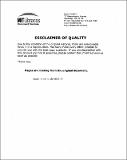Viscoelastic two-dimensional modeling of cell deformation due to shear stress on apical focal adhesion, with experimental design considerations
Author(s)
Hsu, Jeffrey J
DownloadFull printable version (1.879Mb)
Alternative title
Viscoelastic 2-dimensional modeling of cell deformation due to shear stress on apical focal adhesion, with experimental design considerations
Viscoelastic 2D modeling of cell deformation due to shear stress on apical focal adhesion, with experimental design considerations
Other Contributors
Massachusetts Institute of Technology. Dept. of Mechanical Engineering.
Advisor
Roger D. Kamm and Mohammad R. Kaazempur-Mofrad.
Terms of use
Metadata
Show full item recordAbstract
Introduction: Cells are exposed to a wide variety of forces within the human body, and the mechanisms by which cells respond to these forces are largely unknown. From altering gene transcription in the cell nucleus to conformational changes in membrane channel proteins that lead to increased or decreased ion permeability, external stresses imposed on the cell can significantly affect cellular actions through a process known as "mechanotransduction." While such cellular actions include fundamental processes such as cell motility and protein production, the cellular response to external forces can also be pathogenic. For instance, plaque formation within the arteries often occurs at points where the arteries branch or bend sharply, or rather, where cells are subjected to low or reversing fluid shear stresses.
Description
Thesis (S.B.)--Massachusetts Institute of Technology, Dept. of Mechanical Engineering, 2005. "June 2005." Includes bibliographical references (p. 41-43).
Date issued
2005Department
Massachusetts Institute of Technology. Department of Mechanical EngineeringPublisher
Massachusetts Institute of Technology
Keywords
Mechanical Engineering.